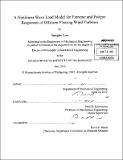| dc.contributor.advisor | Paul D. Sclavounos. | en_US |
| dc.contributor.author | Lee, Sungho, Ph. D. Massachusetts Institute of Technology | en_US |
| dc.contributor.other | Massachusetts Institute of Technology. Dept. of Mechanical Engineering. | en_US |
| dc.date.accessioned | 2012-11-19T19:17:11Z | |
| dc.date.available | 2012-11-19T19:17:11Z | |
| dc.date.copyright | 2012 | en_US |
| dc.date.issued | 2012 | en_US |
| dc.identifier.uri | http://hdl.handle.net/1721.1/74905 | |
| dc.description | Thesis (Ph. D.)--Massachusetts Institute of Technology, Dept. of Mechanical Engineering, 2012. | en_US |
| dc.description | Cataloged from PDF version of thesis. | en_US |
| dc.description | Includes bibliographical references (p. 169-173). | en_US |
| dc.description.abstract | Ocean energy is one of the most important sources of alternative energy and offshore floating wind turbines are considered viable and economical means of harnessing ocean energy. The accurate prediction of nonlinear hydrodynamic wave loads and the resulting nonlinear motion and tether tension is of crucial importance in the design of floating wind turbines. A new theoretical framework is presented for analyzing hydrodynamic forces on floating bodies which is potentially applicable in a wide range of problems in ocean engineering. The total fluid force acting on a floating body is obtained by the time rate of change of the impulse of the velocity potential flow around the body. This new model called Fluid Impulse Theory is used to address the nonlinear hydrodynamic wave loads and the resulting nonlinear responses of floating wind turbine for various wave conditions in a highly efficient and robust manner in time domain. A three-dimensional time domain hydrodynamic wave-body interaction computational solver is developed in the frame work of a boundary element method based on the transient free-surface Green-function. By applying a numerical treatment that takes the free-surface boundary conditions linearized at the incident wave surface and takes the body boundary condition satisfied on the instantaneous underwater surface of the moving body, it simulates a potential flow in conjunction with the Fluid Impulse Theory for nonlinear wave-body interaction problems of large-amplitude waves and motions in time domain. Several results are presented from the application of the Fluid Impulse Theory to the extreme and fatigue wave load model: the time domain analysis of nonlinear dynamic response of floating wind turbine for extreme wave events and the time domain analysis of nonlinear wave load for an irregular sea state followed by a power spectral density analysis. | en_US |
| dc.description.statementofresponsibility | by Sungho Lee. | en_US |
| dc.format.extent | 173 p. | en_US |
| dc.language.iso | eng | en_US |
| dc.publisher | Massachusetts Institute of Technology | en_US |
| dc.rights | M.I.T. theses are protected by
copyright. They may be viewed from this source for any purpose, but
reproduction or distribution in any format is prohibited without written
permission. See provided URL for inquiries about permission. | en_US |
| dc.rights.uri | http://dspace.mit.edu/handle/1721.1/7582 | en_US |
| dc.subject | Mechanical Engineering. | en_US |
| dc.title | A nonlinear wave load model for extreme and fatigue responses of offshore floating wind turbines | en_US |
| dc.type | Thesis | en_US |
| dc.description.degree | Ph.D. | en_US |
| dc.contributor.department | Massachusetts Institute of Technology. Department of Mechanical Engineering | |
| dc.identifier.oclc | 815448909 | en_US |
